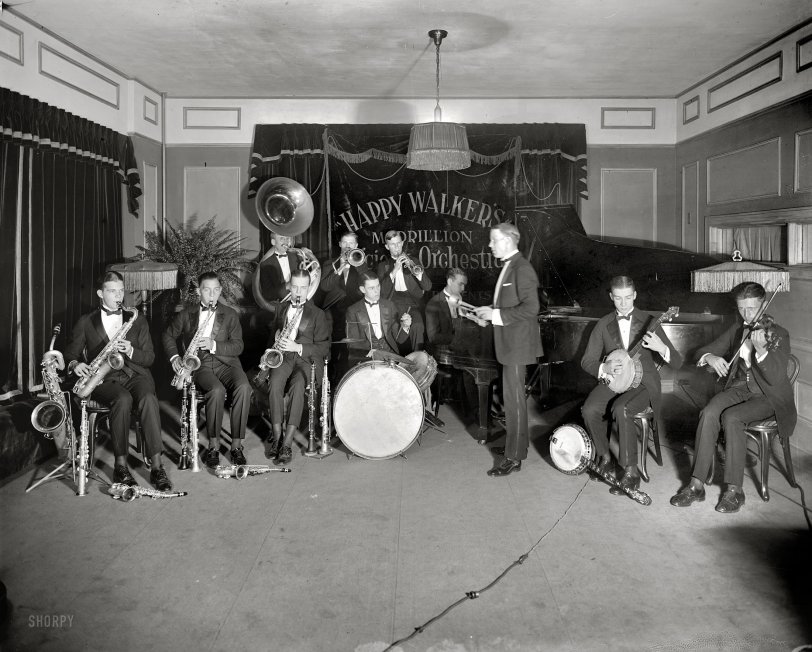


Framed or unframed, desk size to sofa size, printed by us in Arizona and Alabama since 2007. Explore now.
Shorpy is funded by you. Patreon contributors get an ad-free experience.
Learn more.

- If You’re Like Me, Never
- U.S.A.
- S&P
- 1940 Zenith radio model 6G601
- Quality goes in before the name goes on!
- Snazzy skirt
- Carbon Arc Lamps
- Illuminate us
- I remember it well
- I can't prove it
- Complicated then, forgotten now
- Bryan-Stevenson
- Skinny is as skinny does
- How do you rest in peace
- Riding the footboards
- Alas, hidden from view
- Baldwin Diesels
- Exclusive pump
- Bananas, Oysters and Smokey Joe
- Details, Details
- What's that building to the left of the tower?
- Coal Barges
- Bromo-Seltzer
- Inner harbor
- The Basin
- What a headache!
- Giant stepladder?
- Yeah, it was cold
- Love those coats
- Link & Pin Days Remnant
Print Emporium
Society Orchestra: 1923

Washington, D.C., circa 1923. "Happy Walker's Madrillion Society Orchestra." National Photo Company Collection glass negative. View full size.
Banjos
You'll notice that those are 4 string banjos -- tenor banjos. They have the same tuning as a viola. It is possible that the violin player also doubled as a second banjo player, which might explain the two banjos.
Rebranding
In June 1923 the Restaurant Madrillion (1304 G Street NW) described the band in a Washington Post advertisement as Happy Walker and his Victorious Vaudeville Orchestra. In December 1923, the group was described in a Post radio schedule as Happy Walker's Golden Pheasant Orchestra. Within a few months they were simply called Happy Walker and his Golden Pheasants, or Happy Walker's Orchestra.
Yipes! Stripes!
Looks like the violinist hasn't earned his stripes (pants) or maybe he grabbed the wrong pair tonight?
1923, a great year for music
But not in this room. It's probably a good thing that this is a silent picture. I wonder if they had heard the new Gennett sides with King Oliver's band?
Conn artist
Thank you T.K. Tortch for the comprehensive rundown on the woodwinds. The C.G. Conn Company has been a stalwart in quality musical instruments of all types in the United States for many, many years. I played Conn French horns professionally for a long time.
Technical Notes
Me, I'm a fan of vintage saxophones. So focusing on the reed section, Stage Right to Stage Left, looks like we've got:
1. Musician playing a C melody saxophone, sometimes called a "C tenor." Pitched in C, they were wildly popular in the '20s. This one almost certainly made by C.G. Conn Ltd. in Elkhart, Indiana. The big horn to his right, a baritone sax in E-flat, probably by the Buescher Band Instrument Co., also of Elkhart. There are two soprano saxes, one straight standing up, one curved at his feet. Probably one is a C melody soprano and the other the more usual B-flat. They both look like Buescher horns; hard to tell about the straight one.
2. Musician playing an E-flat alto saxophone, almost certainly a Buescher. Two more sopranos, one straight and one curved; they both look like Conn horns. The black instrument is an "Albert System" clarinet, referring to the key layout. That clarinet key system was going out of common use then and is now archaic, though Dixieland traditionalists still like to use them.
3. Musician playing a B-flat tenor saxophone, probably by C.G. Conn. Compare it in size to what Musician #1 is playing; you'll see that his horn looks like the B-flat tenor in shape but is smaller. Standing at his feet one more soprano; hard to say but it looks like a C.G. Conn horn, too; beside that another Albert System clarinet.
All the saxophones, and probably all the brass, look like they are silver plated, though it could be gold. Silver plate was pretty standard then for all metal wind instruments up until after the Depression hit. They all appear to have the also-standard "satin" finish, which was achieved by sand or bead-blasting; the easiest horn to see this on is the big baritone sax at Stage Right; if you look under the lip of the bell you'll see a contrasting shinier area -- that's where the maker has its name engraved along with decoration, and it's just flat engraved but unblasted plated metal. Further, the bells of the saxophones and the brass probably have a light gold wash inside.
The leader's holding what appears to be a trumpet, not a cornet; judging by the multiple vertical braces near the first bend in the tubing on the far side of the bell, you could adjust this instrument's slides to play in a key other than the standard B-flat -- probably a half-step lower in the key of A.
And there are your technical notes for the day.
Deceptive name.
They don't look all that happy.
Buddy Rich would be proud
He's holding his sticks the correct way, he probably even knows how to drum.
Things My Mother Taught Me
1) Always wear clean underwear.
2) Always carry a spare banjo.
Wound a bit too tight
These guys need to unwind with rousing rendition of Motorhead's "Ace of Spades."
























On Shorpy:
Today’s Top 5